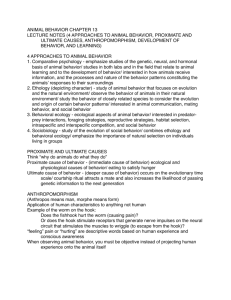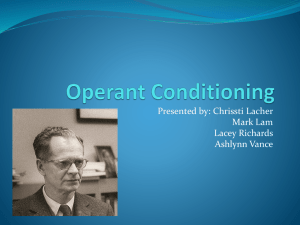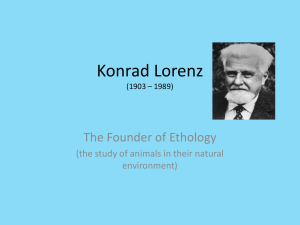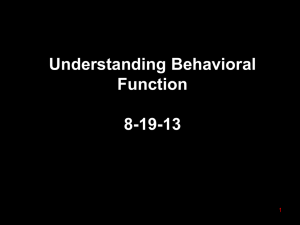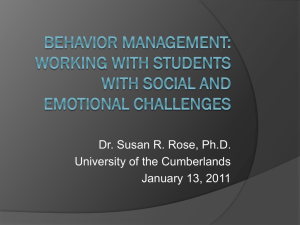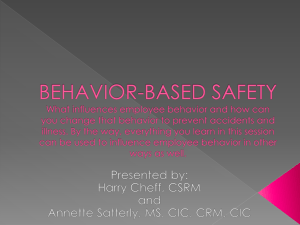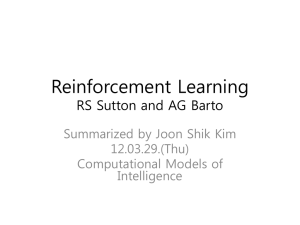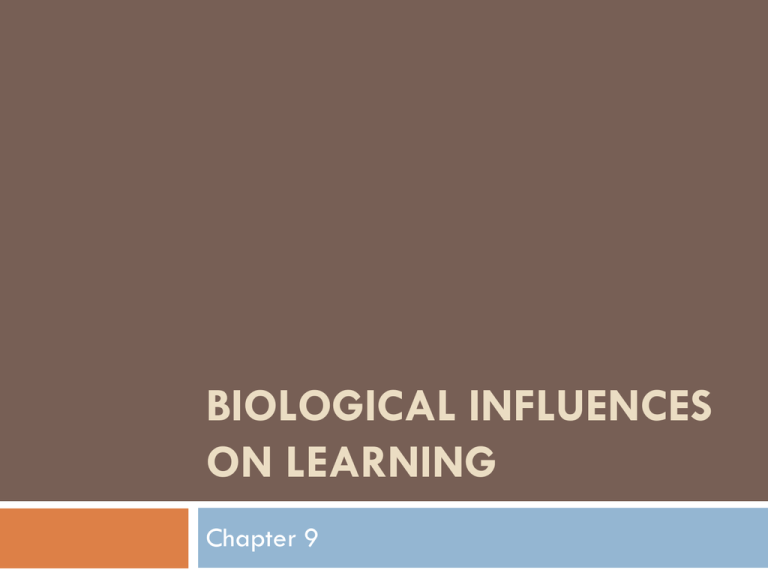
BIOLOGICAL INFLUENCES
ON LEARNING
Chapter 9
General Laws Of Learning
2
Learning is the main determinant of action
Laws of learning reveal themselves in any study of
behavior, even if they are not behaviors exhibited in
a natural setting.
Past
experience do not interfere with the learning
involving arbitrary stimuli in the laboratory.
Conducted in humans and non human animals.
The specific CS, US (Pavlovian), reinforcer, and response
(Instrumental) is arbitrary.
Extreme
Enviromentalist and Nuturist!!!!!
Watson and General Laws
3
“The behaviorist, ……. recognizes no dividing line between
man and brute. The behavior of man, with all of its
refinement and complexity, forms only a part of the
behaviorist's total scheme of investigation”
"Give me a dozen healthy infants, well-formed, and my own
specified world to bring them up in and I'll guarantee to
take any one at random and train him to become any type
of specialist I might select—doctor, lawyer, artist, merchantchief, and, yes, even beggarman and thief, regardless of his
talents, penchants, tendencies, abilities, vocations, and race
of his ancestors”
A Possible Rapprochement
4
One General
Law
Millions of
Specific Laws
Exaptations
(serving one particular function, but later
but modified to serve another)
Flying Dinosaurs and Exaptations
5
Feathers for thermoregulation
Recycled for flight
So, modes of learning
should be conserved and
modified for other
purposes
Behavior Systems Approach
6
Learning acts within innate behavior systems and functions to
change the integration, tuning, instigation, or linkages.
According to Timberlake, an animal possesses instinctive
behaviors such as feeding, mating, social bonding, care of
young, and defense.
7
Learning improves simple and complex motor tasks
through repetition.
Activation of a mode can also be conditioned to cues
that signal the receipt of reinforcers.
Conditioning of a specific mode produces a general
motivational state that sensitizes all of the
perceptual-motor modules in that mode.
Different stimuli can be conditioned to different
modes.
Variations of learning can occur between species.
Constraints and Predispositions
8
Constraints
When
learning occurs less rapidly or less completely
than expected.
Predispositions
Instances
where learning occurs more rapidly or in a
different form than expected.
Constraints: Animal Misbehavior
9
Breland & Breland (1961) initiated the use of
instrumental procedures to teach exotic behaviors to
animals.
Animals
learned the behaviors, but began showing
instinctive behaviors.
Instinctive drift
When instrumental behavior deteriorates despite
continued reinforcement due to the elicitation of
instinctive behaviors.
IQ Zoo
Animal misbehavior may also be a result of Pavlovian
conditioning.
For misbehavior to develop, stimuli resembling the
natural cues must be consistently paired with the
reinforcer and must reinforce naturally occurring
species-typical behavior.
Constraints: Schedule-Induced Behavior
11
Skinner (1948) found that reinforcing pigeons on an
FI-15 sec. schedule resulted in stereotyped behavior.
Superstitious behavior
Skinner
thought the “ritualistic” stereotyped pattern of
behavior may have associated superstitious behavior
with reinforcement.
Alternative view is the ritualistic behavior fill the
“behavioral vacuum” between rewards
12
Terminal behavior
Interim behavior
The behavior that precedes reinforcement when an animal is
reinforced on an interval schedule of reinforcement.
The behavior following reinforcement when an animal is
reinforced on an interval schedule of reinforcement.
Schedule-induced behavior
The high levels of instinctive behavior that occur following
reinforcement on an interval schedule.
Schedule-Induced Polydipsia (SIP)
13
The high levels of water consumption following food
reinforcement on an interval schedule.
Some
important aspect of food can produce excessive
drinking.
Has been observed in rats, pigeons, and nonhuman
primates.
Usually occurs in the immediate time following
reinforcement and decreases as time for the next
reinforcement nears.
SIP
Group
Control
Group
The Nature of Schedule-Induced Behavior
15
Riley and Wetherington (1989) proposed that
schedule-induced instinctive behavior is a product of
periodic reinforcement.
The relative insensitivity of water-induced
polydipsia to taste aversion is compelling evidence
of this.
Does Schedule-Induced Behavior Occur in
Humans?
16
Gilbert (1974) suggested that interval schedules
could be responsible for some peoples’ excessive
alcohol consumption.
Rats on interval schedules show excessive consumption
of ethanol; cocaine solution.
Arm-Chair Quarterback Blitzed
17
Budweiser Sipping
Stay
Go
Inter-Potato Chip Interval
18
Schedule-induced polydipsia in animals is a good
model for excessive alcohol consumption in humans.
Smoking and eating are other type of scheduleinduced behaviors seen in humans.
Evidence
is weaker in humans, and natural schedule
induced behavior develops more slowly in humans than
in animals.
Schedule-Induced “Chin Rubs”
19
Scheduled-Induced Anorexia
20
Rats fed once
per day at the
same time
Periodic 24
hour schedule
Free-access to
wheel (or not)
Activity-Induced Anorexia
21
Predispositions and Taste Aversion
22
Preparedness?
Avoidance
of a flavor that precedes an illness
experience (implies selectivity)
Long-delay learning?
The
association of a flavor with an illness that occurred
even several hours after the flavor was consumed. Is this
a special type of learning
The Selectivity of Flavor Aversion Learning
23
Garcia and Koelling (1966) demonstrated this
phenomenon in a groundbreaking study with rats.
Seligman (1970): rats possess an evolutionary
preparedness for flavor aversion learning.
Rats can also associate an environmental cue with
illness.
Taste
cues, however, are especially salient.
24
Birds acquire visual aversions more readily than
taste aversions.
Rely
more heavily on visual system for food.
Search for food during the day.
Rats are nocturnal, and rely more heavily on
gustatory information to find food.
Long-delay learning?
25
Concurrent interference
The
prevention of learning when a stimulus intervenes
between the conditioned and unconditioned stimuli or
when a behavior occurs between the operant response
and reinforcement.
Long-delayed learning occurs as the absence of
concurrent interference
Interference is observed if other tastes are introduced.
Flavor Aversion Learning in Humans
26
Many children in the early stages of cancer
develop flavor aversions before toxic
chemotherapy.
Adult and child cancer patients receiving radiation
therapy.
Causes
weight loss in these individuals.
Mapletoff ice-cream as a surrogate
Imprinting
27
Imprinting
Lorenz (1952) found that infant birds form
attachments to the first moving object they encounter.
The development of a social attachment to stimuli
experienced during a sensitive period of development.
Birds may imprint to inanimate objects as well as animals of
another species.
Conditions influences the likelihood of imprinting.
Conditions Influence Imprinting
28
Klopfer (1971) found that ducklings imprinted more
readily to a moving object than a stationary object.
Harlow (1971) studied this phenomenon in nonhuman
primate surrogate, cloth mothers.
Ainsworth (1982) has studied the effect of imprinting
on human infants.
Imprinting can still occur after sensitive development
periods when sufficient experience is given.
The sensitive period for attachment differs among
species.
Sexual Preference
29
The sexual preference of many birds is established
during the sensitive period.
Does
not have to be of the same species.
Sexual preference, thus, does not depend upon sexual
reinforcement.
Is not modified even after sexual experience with
another bird species.
Nature of Imprinting
30
Moltz (1960, 1963) proposed that Pavlovian and
operant conditioning are responsible for social
imprinting.
Before the fear system develops, chicks orient to
large, familiar and unfamiliar objects (e.g., the
mother) with low levels of arousal.
Fear system develops, unfamiliar objects elicit high
arousal.
Chicks cling to their mother associated with lower
levels of arousal
31
Fear reduction may be associated with “mama” in
young human and nonhuman primates
Harlow (1971) used inanimate surrogate mothers of
different forms (both wire and cloth) for nonhuman
primate infants.
Primates
clung to the cloth surrogate in the presence of
a dangerous object, but fled when only the wire
surrogate was present.
32
The research of Ainsworth and colleagues:
Secure relationship
The
establishment of a strong bond between a mother
who is sensitive and responsive to her infant.
Anxious relationship
The
relationship developed between a mother and her
infant when the mother is indifferent to her infant.
33
Instinctive view of Imprinting
The
view that imprinting is a genetically programmed
form of learning.
Kovach and Hess (1963) found that, despite its
administration of electric shock, chicks still approached
the imprinted object.
Punishment may not inhibit imprinting.
Primate infants clung to abusive “monster mothers” even
as they were abused (Harlow, 1971).
Brain Mechanisms of Reward
34
Electrical Brain Stimulation
Brain stimulation can be used as reinforcement.
Many species will act to earn brain stimulation.
Medial Forebrain Bundle or MFB (James Olds)
Characteristics
35
Has 4 characteristics:
Highly reinforcing
Motivates ongoing behavior
Its functioning is stimulated by the presence of reinforcers
Its reinforcing effects are enhanced by deprivation
36
Stimulus-bound behavior
Behavior tied to the prevailing environmental conditions and
elicited by stimulation of the brain’s reinforcement center.
Activation of the MFB reinforces behavior.
Watching erotic films leads to stimulation of the MFB and
sexual activity.
Also has been shown to eliminate pain in cancer patients.
Produces a strong euphoria that lasts several hours.
“Liking” versus “Wanting”
37
Hypothesis #1: Hedonia, dopamine (DA) acts as a
“pleasure neurotransmitter”.
drugs of abuse are involved dopamine activity,
particularly in the "high" or euphoric state
However, not all rewards or pleasurable things
involve activation of the reward system
Hypothesis #2: Incentive salience (wanting, “do it
again” or “craving”) stands out as a possible role for
dopamine as it regard.
Mesolimbic Reinforcement System
38
The MFB is only part of the brain’s reinforcement
center.
Mesolimbic reinforcement system
A
central nervous system structure that mediates the
influence of reinforcement on behavior.
Tegmentostriatal pathway and nigrostriatal pathway.
40
Tegmentostriatal pathway
A
neural pathway that begins in the lateral
hypothalamus, goes through the MFB and ventral
tegmental area, terminates in the nucleus accumbens,
and governs the motivational properties of reinforcers.
Ventral tegmental area (VTA)
A
structure in the tegmentostriatal reinforcement system
that projects to the nucleus accumbens.
41
Nucleus accumbens (NA)
A
basal forebrain structure that plays a significant role
in the influence of reinforcement on behavior.
Nigrostriatal pathway
A
neural pathway that begins in the substantia nigra
and projects to the neostriatum and that serves to
facilitate reinforcement-induced enhancement of
memory consolidation.
42
One line of evidence of DA influence is the powerful
reinforcing properties of amphetamine and cocaine,
which increase the level of activity at dopaminergic
receptors.
Animals quickly learn behaviors to self-administer
amphetamine and cocaine.
Natural reinforcers (e.g., food and water) also trigger
dopamine release, as does MFB stimulation.
Opiate Activation of the Tegmentostriatal
Pathway
43
Opiate drugs also stimulate the tegmentostriatal
pathway.
Animals
learn to self-administer opiate drugs such as
heroin and morphine.
Opiate drugs do not activate DA receptors.
Both DA and opiate receptors produce activation in the
NA.

